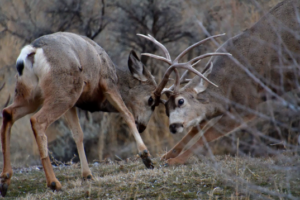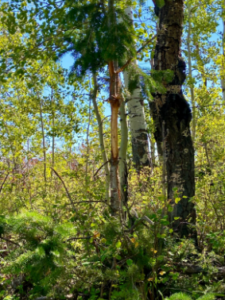The Greater Yellowstone Ecosystem is a wildlife lover’s paradise, especially during the fall mating season. In our recent blog ‘What is the elk rut and where can I hear bugling?’ we covered the intensity of the elk rut, characterized by loud bugling. The mule deer rut is generally quieter, with bucks using somewhat more subtle tactics to attract does. Elk form large herds during the rut, while mule deer are more solitary or travel in smaller groups. The specific timing and duration of the mule deer rut in Wyoming can vary depending on factors such as weather conditions and habitat, but it typically occurs in late October through December.
Behavior

Mule deer bucks engage in a variety of behaviors during the mating season to attract does and establish dominance. Sparring, which involves pushing, shoving, and locking antlers, is a common tactic used to determine which bucks will have the most breeding opportunities. In some cases, dominant bucks may chase away other bucks that are vying for the attention of does.
Additionally, bucks often grunt to communicate with other bucks and does, and they may also posture by standing tall and spreading their legs to intimidate rivals or impress potential mates.

By rubbing their antlers on trees or rocks, bucks leave behind a scent marking that indicates their presence and territory. This helps to deter other bucks from entering their area and competing for does. Mule Deer also rub their antlers after they have completed growth in the Fall in order to remove the velvety (finely hairy) skin that provides nutrients through blood flow for the developing antlers, and insulation for the circulating blood. Rubbing can help to strengthen the muscles in their necks and shoulders, which can be beneficial for fighting off other bucks.
Local residents in Jackson Hole have to put temporary fencing around young trees if they want to protect the trees from Mule Deer rubbing in the Fall
Observing the Mule Deer Rut
If you’re lucky enough to be in the Greater Yellowstone Ecosystem during the late fall, you may have the opportunity to witness the mule deer rut. Here are some tips for maximizing your chances:
- Timing: As mentioned, the rut typically occurs in late fall. Wildlife Expeditions guides can keep you in the loop as to when the rut is starting for this particular season.
- Location: Look for areas with open meadows or sagebrush flats, as these are often preferred habitats for mule deer.
- Patience: Remember, the mule deer rut can be a bit more elusive than the elk rut. Be patient and observant, and you may be rewarded with a glimpse of this fascinating natural phenomenon.
Eager to experience the mule deer rut and other wildlife wonders of the Greater Yellowstone Ecosystem this fall? Teton Science Schools offers a variety of tours that provide expert insights and enhance your chances of observing wildlife in their natural habitat. Book here.
Sources:
- National Park Service: https://www.nps.gov/yell/learn/nature/mule-deer.htm
- Wyoming Game and Fish: https://wgfd.wyo.gov/wildlive/mule-deer
Greater Yellowstone Coalition: https://greateryellowstone.org/


